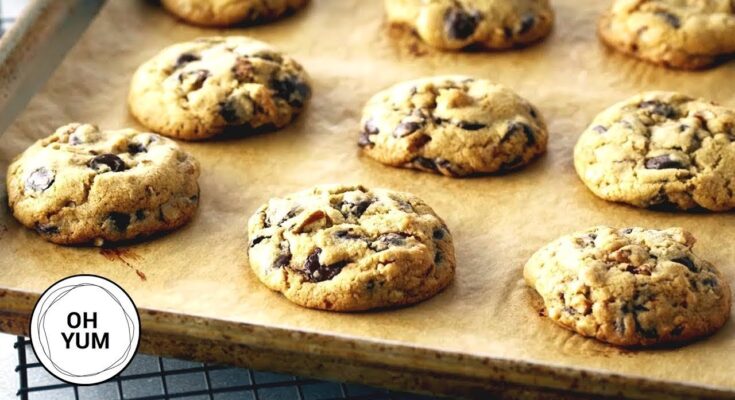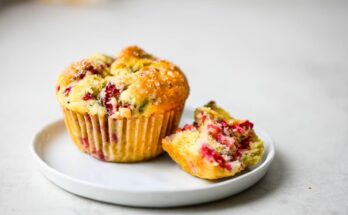Best Cookie Recipe: There’s something universally comforting about a warm, gooey cookie. Whether it’s the nostalgic smell wafting through your home or the satisfying bite of melted chocolate, cookies are more than just a treat—they’re an experience. Having a go-to cookie recipe in your baking arsenal is like having a superpower. It turns a boring afternoon into a cozy moment, a surprise visit into a sweet delight, or a stressful day into a bite of happiness.
This guide isn’t just about any cookie recipe—it’s about the best one. One that gives you soft centers, crispy edges, and flavor that hits just right. We’re diving deep into what makes a cookie perfect, step by step. You’ll learn the science, the tips, and the tricks behind every delicious bite. Ready to master the art of cookie baking? Let’s get that oven preheating!
Key Ingredients for Perfect Cookies
To make the best cookies, you need more than just a standard ingredient list—you need to understand why each component matters. Think of ingredients as the cast of a blockbuster movie. Every role is essential.
Choosing the Right Flour
All-purpose flour is the go-to for most cookie recipes—and for good reason. It strikes a balance between chewiness and structure. But not all all-purpose flours are created equal. Look for unbleached versions with a mid-range protein content (around 10-12%). Too much protein (like bread flour)? You’ll get tough cookies. Too little (like cake flour)? Your cookies might fall apart or be too soft.
You can experiment with blending flours—half all-purpose, half cake flour—for super tender results. Just be sure to sift your flour to avoid clumps, and always measure using the spoon-and-level method for accuracy.
Importance of Butter and Sugar Ratio
Butter is the soul of your cookie. Use unsalted, high-quality butter—room temperature is best for creaming with sugar. Speaking of sugar, it’s not just for sweetness. Granulated sugar gives crispness, while brown sugar adds moisture and chewiness thanks to its molasses content. The magic ratio? Half and half for balanced texture and taste.
Want to level up? Brown your butter first. It adds a rich, nutty flavor that takes cookies to gourmet status. Just remember to chill browned butter before using it in your dough.
The Magic of Vanilla Extract
Vanilla might seem like a minor player, but it’s a total flavor booster. A splash of real vanilla extract (not the imitation kind) elevates your cookie’s depth. You can also try vanilla bean paste if you’re feeling fancy—it’s more concentrated and adds beautiful specks throughout the dough. Think of it as the difference between regular coffee and a barista-crafted espresso.
Tools You’ll Need for Baking
You don’t need a commercial kitchen to make bakery-quality cookies. Just a few essentials can get the job done beautifully.
Must-Have Baking Equipment
- Mixing Bowls – At least two: one for wet, one for dry.
- Measuring Cups & Spoons – Precision matters in baking.
- Electric Mixer or Whisk – Hand or stand mixer helps with creaming.
- Baking Sheet – Heavy-duty, rimless sheets for even heat.
- Parchment Paper or Silicone Mat – Prevents sticking and promotes even browning.
- Cookie Scoop – Ensures uniform size for even baking.
- Wire Cooling Rack – Keeps bottoms from getting soggy post-bake.
Optional Tools That Make Life Easier
- Digital Kitchen Scale – Super accurate, especially for flour.
- Cookie Spatula – Thin and flexible for lifting delicate cookies.
- Oven Thermometer – Because most ovens lie about their temp.
Getting your setup right not only saves time but also increases your chances of baking perfection every time.
Step-by-Step Instructions to Bake the Best Cookies
Now for the fun part—actually baking those melt-in-your-mouth cookies. Follow these steps closely, and you’ll be rewarded with cookies that impress every time.
Step 1: Gather and Measure Your Ingredients
Before you even preheat the oven, get everything ready. Measure out flour, sugar, butter, eggs, and chocolate chips. Trust me, mid-recipe scrambling is a recipe for disaster. A clean workstation equals a stress-free bake.
Pro tip: Crack your eggs into a separate bowl before adding them to the dough. It avoids shell surprises and lets you check for freshness.
Step 2: Creaming Butter and Sugar – Why It Matters
Creaming is the process of beating butter and sugar together until fluffy and pale. This isn’t just mixing—it incorporates air, giving your cookies structure and softness. Take 3-5 full minutes using an electric mixer on medium-high speed. It should look light and creamy before you move on.
Step 3: Adding Eggs and Vanilla
Now that your butter and sugar are beautifully creamed, it’s time to bring in the moisture and flavor—eggs and vanilla. Crack in one egg at a time, mixing thoroughly after each addition. This helps create a smooth and stable dough without overmixing.
Once your eggs are incorporated, add the vanilla extract. For that irresistible aroma and depth of flavor, don’t skimp—use at least one teaspoon of pure vanilla extract. This small addition adds a rich, comforting scent and taste that rounds out the sweetness from the sugar.
At this stage, your dough should be smooth and slightly glossy. It’s already smelling amazing, and we haven’t even gotten to the dry ingredients yet.
Step 4: Incorporating Dry Ingredients Slowly
Here’s where many cookie dreams go wrong—dumping the flour all at once. Nope, slow and steady wins the race here. In a separate bowl, whisk together your flour, baking soda, and a pinch of salt. Then, gradually add the dry mix into your wet ingredients in thirds.
Use a low mixer speed or a wooden spoon to gently blend until just combined. You want to avoid overmixing, which can lead to tough cookies. The dough should be thick and hold its shape, but not dry or crumbly. Scrape down the sides of the bowl to ensure everything is fully incorporated.
This method helps maintain that chewy-soft texture everyone craves, without losing structure or flavor.
Step 5: Mixing in Chocolate Chips or Other Add-ins
Here’s the fun part—mix-ins! The classic is, of course, semi-sweet chocolate chips. But you’re not limited to those. Try dark chocolate chunks, white chocolate, toffee bits, chopped nuts, or even sprinkles for a birthday cookie vibe.
Add 1 to 1½ cups of your mix-ins, folding them gently into the dough with a spatula or wooden spoon. Make sure they’re evenly distributed so every bite is packed with goodness.
Feeling bold? Throw in a mix of chocolate types for depth—like half milk and half dark. Or add a touch of sea salt on top before baking for that sweet-salty combo that hits every craving.
Step 6: Chilling the Dough – Don’t Skip This!
I know, I know—you want cookies now. But trust me: chilling the dough is the secret to next-level cookies. Pop your dough in the fridge for at least 30 minutes, or even overnight if you can wait that long.
Why chill? It firms up the butter, preventing spreading in the oven. It also gives the flour time to hydrate and the flavors to develop. The result? Thicker, chewier, and more flavorful cookies with a perfect golden brown exterior.
If you’re short on time, scoop the dough into balls and chill those. It speeds up the process and makes baking faster when you’re ready.
Step 7: Scooping and Placing Dough on Tray
Once your dough is chilled, it’s time to scoop. Use a cookie scoop or spoon to portion out even dough balls, around 1.5 to 2 tablespoons each. Space them out well—cookies spread, and you don’t want a cookie blob mess.
Place them on a parchment-lined baking sheet, giving at least 2 inches of space between each one. For extra pizzazz, press a few chips or toppings on top before baking so they look bakery-worthy once done.
Want perfectly round cookies? Roll each scoop into a ball with your hands for that smooth, uniform finish.
Step 8: Baking to Golden Perfection
Preheat your oven to 350°F (175°C)—make sure it’s fully up to temp before baking. Slide your tray into the middle rack and bake for 10 to 12 minutes. The edges should be lightly golden while the centers still look slightly underbaked.
Don’t be tempted to bake until they look fully done—cookies continue to cook as they cool on the tray. That underbaked center? It’s the key to that gooey, soft middle.
Rotate the tray halfway through if your oven has hot spots. Once done, let them cool on the tray for 5 minutes before transferring to a wire rack.
Step 9: Cooling and Storage Tips
Cooling your cookies properly is just as important as baking them. Letting them rest on the tray helps them set, while the wire rack prevents soggy bottoms. Give them 15-20 minutes before digging in—if you can wait that long!
For storage, keep cookies in an airtight container at room temperature. They’ll stay fresh for 4-5 days. Want to keep them soft? Toss a slice of bread in the container. The cookies absorb moisture from the bread, not the other way around!
You can also freeze baked cookies for up to 3 months, or freeze unbaked dough balls and bake them fresh whenever the craving hits.
Pro Tips for Perfect Cookies Every Time
Even with the best recipe, small details make a big difference. Want cookies that consistently wow every single time? These pro tips will seriously upgrade your cookie game:
- Use room temperature ingredients. Cold butter or eggs can prevent proper mixing and affect texture. Take your ingredients out about 30 minutes before you start.
- Weigh your ingredients. Precision matters. A digital scale helps you get the flour-to-fat ratio just right, preventing dry or greasy cookies.
- Don’t overmix. Once you add flour, be gentle. Overworking the dough develops gluten, which can lead to tough, dense cookies.
- Test bake one cookie. Before baking a full tray, test one cookie to check spread, texture, and bake time. You can adjust your dough if needed.
- Rotate trays. Halfway through baking, rotate your cookie sheet for even browning—especially if your oven has hot or cold spots.
- Customize sweetness and salt. Love a salty-sweet bite? Sprinkle a little flaky sea salt on top right before baking. Too sweet? Reduce sugar by 10%, but never skip it altogether—it affects texture, too.
- Let them rest. Cookies are often better the next day. Flavors deepen, and the texture stabilizes. Bake today, enjoy tomorrow—if you can resist.
Following these tips doesn’t just give you better cookies—it makes you a smarter baker, and that confidence shines through in every batch.
Variations to Try – Go Beyond Chocolate Chip
Once you’ve mastered the classic cookie, it’s time to experiment. You can create a whole cookie collection just by tweaking the base dough and mix-ins. Here are some delicious variations to try:
- Peanut Butter Chocolate Chip
Swap half the butter for peanut butter and add chocolate chunks for a nutty, rich twist. - White Chocolate Macadamia
Use white chocolate chips and chopped macadamia nuts for a buttery, crunchy treat. - Oatmeal Raisin
Add rolled oats, raisins, and a pinch of cinnamon. Swap out some flour for oats for a chewy texture. - S’mores Cookies
Mix in mini marshmallows, graham cracker chunks, and milk chocolate chips for a nostalgic fireside snack. - Salted Caramel Pretzel
Add caramel bits and crushed pretzels for a sweet-salty-crunchy combo. - Red Velvet Cookies
Add cocoa powder and red food coloring to the dough, then mix in white chocolate chips for a stunning visual and rich taste. - Mocha Espresso
Add a tablespoon of instant espresso and dark chocolate chips for a caffeinated cookie that pairs perfectly with your morning coffee.
Don’t be afraid to get creative. Your pantry can be your playground. Just keep the base dough balanced and the possibilities are endless.
Common Mistakes to Avoid
Even experienced bakers can slip up sometimes. Avoid these cookie catastrophes to keep your batches consistently awesome:
- Skipping the chill. Warm dough spreads too much and gives you flat, greasy cookies.
- Using old leavening agents. Baking soda and powder lose potency over time. Replace them every 6 months for best results.
- Overbaking. Cookies continue baking after they’re out of the oven. Pull them while they still look slightly underdone in the center.
- Too much flour. Packing flour into a measuring cup can add way more than needed, making cookies dry. Spoon and level, or better yet, weigh it.
- Using melted butter (when not called for). Unless the recipe specifies it, melted butter can cause excessive spreading.
- Crowding the tray. Cookies need space to spread evenly. Too many on a tray = uneven baking and cookie collisions.
- Not preheating the oven. Starting with a cold oven can mess with bake time and texture. Always preheat fully.
Avoiding these mistakes is just as important as following the steps. Baking is as much about awareness as it is about the ingredients.
FAQs About Best Cookie Recipe
1. What is the secret to making the best cookies?
The secret lies in using quality ingredients, measuring accurately, chilling the dough, and not overbaking. A mix of brown and white sugar also gives cookies a perfect chewy texture and rich flavor.
2. Should I use butter or margarine for cookies?
Butter is best for cookies because it adds flavor and helps create the perfect texture. Margarine often contains more water and can lead to flat or cakey cookies.
3. Why do my cookies spread too much while baking?
This usually happens when the dough is too warm or there’s too much butter. Chilling the dough for at least 30 minutes before baking helps prevent spreading.
4. Can I freeze cookie dough?
Absolutely! Cookie dough freezes well for up to 3 months. Just scoop into portions, freeze on a tray, then transfer to a sealed bag. Bake straight from frozen—just add 1–2 extra minutes.
5. How do I keep cookies soft and chewy?
Store them in an airtight container with a slice of bread. The moisture from the bread keeps cookies fresh and soft for days.
6. Can I substitute all-purpose flour with other flours?
You can, but the texture will vary. Almond flour or oat flour can work in some recipes, but always follow specific guidelines or use a tested gluten-free version for best results.
7. What’s the best way to bake evenly sized cookies?
Use a cookie scoop or tablespoon to measure dough evenly. This ensures uniform baking and a consistent batch every time.
Conclusion
And there you have it—the ultimate guide to baking the best cookies of your life. Whether you’re a newbie baker or a seasoned cookie connoisseur, following these step-by-step instructions, pro tips, and creative variations will ensure you never settle for store-bought again.
Baking cookies isn’t just about satisfying a sweet tooth. It’s about creating memories, bonding with family and friends, and finding joy in the little things. From the warm aroma filling your kitchen to that first chewy bite, cookies are a timeless, soul-soothing treat.
So the next time life gets a little too hectic, grab your mixing bowl, scoop some dough, and bake your way to bliss—one perfect cookie at a time.



